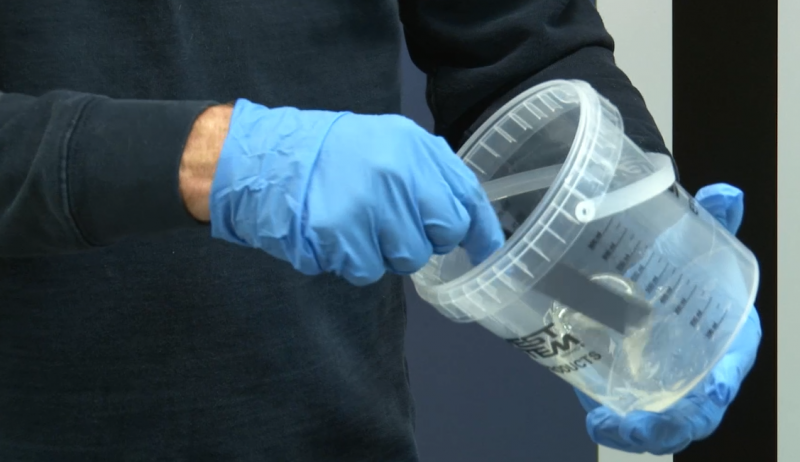Trade Secrets: Essential Guide to Thinning Epoxy

What are the best practices for thinning epoxy resin and what factors should you consider before starting the process?
Adding a solvent to WEST SYSTEM® Epoxy reduces its viscosity, making it easier to apply. This also allows it to penetrate deeper into porous surfaces like partially rotten wood and saturate faster into fibreglass fabric. For these reasons, many people are attracted to the idea of thinning epoxy.
However, what mustn’t be overlooked is that reducing viscosity can also change the makeup of the epoxy. This impacts both its strength and moisture resistance. It also affects the time it takes for the epoxy to gel.
Before you decide to thin your epoxy, it’s important to weigh up the benefits against the potential risks. If you decide to go ahead, the next consideration is whether to use heat or a solvent to thin your epoxy.
What are some common misconceptions about thinning epoxy resin that people should be aware of?
The technical staff at WEST SYSTEM often speak to customers who believe that epoxy needs to penetrate deeply into wood to be effective. Although that can be the case, most of the time it’s not necessary. This often means customers are thinking of thinning epoxy when it might not actually be beneficial.
The thinner it is, the more porous it is likely to become.
A neat epoxy coating on the surface, for example, provides far better water resistance than thinned epoxy. This is because the thinner it is, the more porous it is likely to become. Similarly, adhesion depends on the surface area of a joint. It also depends on the strength of the wood and the strength of adhesive used. Contrary to popular belief, it does not depend on how deeply the epoxy has penetrated. When it comes to rotten wood, although thinned epoxy certainly makes it harder. However, it doesn’t regain its original strength.
If you’re thinking of thinning epoxy for any of these reasons, you need to be aware of the possible implications. You should also consider whether it is strictly necessary. If you think it is, then our guide will tell you what you need to know to thin epoxy effectively:
What are the effective methods for thinning epoxy resin using heat and what precautions should be taken?
There are two options if you want to use heat to thin epoxy. You can heat the resin and hardener components separately and then mix them together to create a thinned epoxy; or you can heat the substrate – such as wood – and apply your room-temperature resin and hardener mix to the heated surface.
A heated mix of resin and hardener does retain all the characteristics of epoxy cured at room temperature but it cures faster, which can catch people out. Using WEST SYSTEM 206 Slow Hardener® or WEST SYSTEM 209 Extra Slow Hardener® can help with this, as these two hardeners have a slow cure speed which gives you more time to work with the heated epoxy.
If you’re coating wood, the best method is to warm the wood rather than the epoxy. Remove the heat source just before applying epoxy and the mixture will thin as it comes into contact with the wood. As the wood cools, the epoxy is filters deeply through before gelling as the air in the wood fibre contracts.
Whichever method you use, you should be able to comfortably touch the epoxy containers or the wood, so heat them to a maximum of 35˚C. Overheating causes the epoxy to harden too fast. If you see smoke rising from the cured epoxy, it is probably damaged and needs to be replaced as a precaution.
How Can You Thin Epoxy Using a Solvent Safely and Effectively?
Adding a solvent… can create drastic changes.
Whereas heating epoxy can enable you to maintain the original epoxy characteristics, adding a solvent such as acetone, lacquer thinner or denatured alcohol can create drastic changes. We do not recommend thinning epoxy with solvent at any time, and here’s why:
- Adding 5% lacquer thinner to epoxy reduces epoxy’s compressive strength by 35%. As such, it’s no longer suitable as a structural adhesive.
- Adding a solvent can extend curing time, making your work unpredictable.
- Adding a solvent can cause the epoxy to shrink and crack over time. This happens if the solvent doesn’t evaporate before the epoxy hardens, but then finds its way out of the mix over time.
- Adding a solvent such as acetone can change the colour of cured epoxy.
- Adding a solvent can damage substrates such as Styrofoam – so test your solvent on your substrate before thinning your epoxy.
- Adding a solvent can increase the risk of fire and damage your health.
- Adding a solvent to wet out fibreglass quickly can create resin-starved fabric if excess epoxy drains out of vertical surfaces.
Our recommendation is always to thin epoxy using heat because it allows you to maintain the original characteristics of the epoxy and is not unpredictable and risky like thinning with a solvent.
This recommendation comes with a caveat though: by thinning epoxy, you’re altering the composition of WEST SYSTEM products that have been refined over many years. That’s not to say you should never do it, but it does mean that you need to think and act carefully when you do. If it’s not necessary, then why take the risk?
Want to find out more? Read our guide to using WEST SYSTEM epoxy products.



